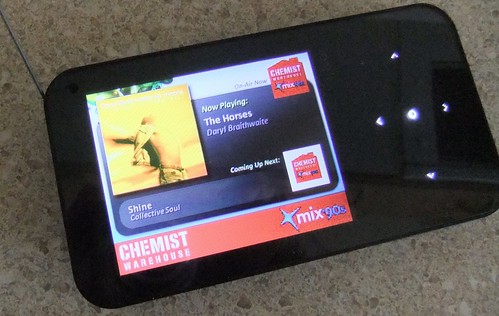It’s all the rage to claim “firsts” in the radio industry, and BBC Radio 1 is no exception. Writing in the Huffington Post UK (wha?), the lovely Joe Harland, “Head of Visualisation” for Radio 1, says:
This Sunday at 6pm Reggie Yates will become the first Radio 1 presenter to play not a record, CD, or Wav, but a DVD. … This Sunday, when Reggie proudly presses play on his Pioneer DVJ for the first time, it is the start of something you’ll be hearing – and seeing – a great deal more of from radio stations around the world.
This form of visualising radio – playing the music video alongside the audio – is nothing new, of course. Cameras invaded the Chris Evans Breakfast Show at Virgin Radio in 1998, simulcasting the show on Sky One: while he didn’t play DVDs but rather beta video tapes, the concept was the same.
RMF MAXXX, a station in Poland, did something even closer in the mid 2000s: DJs would self-op their programmes, but wearing in-ear headphones, lit and made-up for TV, and looking directly at the camera (since that was where their notes were, on an auto-cue). It sounded like radio, but looked like television. Videos would play off the station’s playout system: just like the audio.
Making a TV simulcast from the Radio 1 Top 40 – something that Joe specifically denies they’re doing (oddly) – is clearly a sensible, bright thing to do: for all the reasons Joe gives in his post. The Radio 1 brand is, actually, no longer a radio brand but a youth entertainment brand: and that’s a good thing.
However.
The phrase “visualising radio” is, however, being used for two entirely different things within radio, and for two different ends.
First, there’s “making television”. By that I mean producing a live video stream, with cameras in studios, music videos, captions, scrolling tickers and fancy wipes. Putting radio onto a video stream is a great thing to do. KISS is doing a great job, for example, of editing their breakfast show and putting it on YouTube.
If you’ve the resources to make television, that’s cool. Television isn’t a true multitasking medium, like radio is. The benefits of radio’s “theatre-of-the-mind” is laid bare with cameras in studios. Presenters have a tendency to act up to the cameras, and ignore the radio audience. But those are all controllable. Making television from radio is not the wrong thing to do.
Then, there’s “adding visuals to radio”. I’m specifically not talking here about video. I’m talking about things that allow audiences to engage when they want to, and discover more about what they’re listening to.
There are two great examples of this: the RadioVIS-like experience you get when you listen to Capital FM on the Radioplayer. Static slides appear containing news, travel information, now-playing stuff, weather, pictures of the DJs, and more glanceable information. This also appears on radio devices, too.
Another great example of this is the BBC Radio 1 homepage. As you listen, more information appears to let you learn more about what you’re hearing. Images of songs, tweets and Facebook messages from the audience, promotion of other things on the station, and links to video and more. Once more, it’s glanceable information that allows more interaction when you’ve the time to do so.
This is stuff that enhances a radio broadcast – stuff that can be completely automatable, and stuff that reflects what’s on that radio station. It’s not television.
Both of these things are currently called “visualising radio”. I think they’re both healthy for the future of the medium; and very different.
Permalink | No comments yet
Post tags: radio
These are my personal views | Full disclosure

